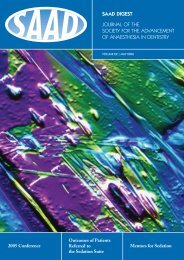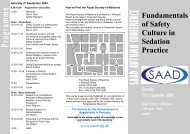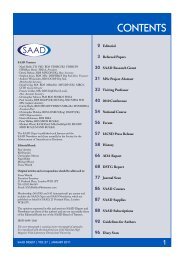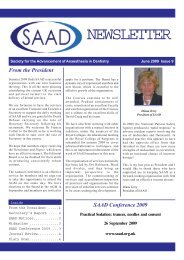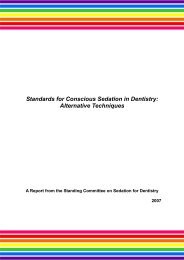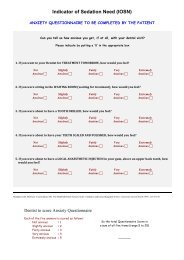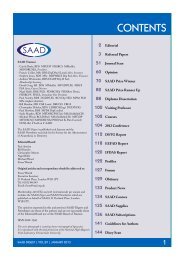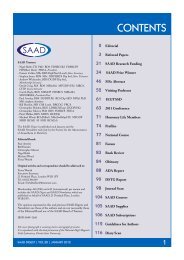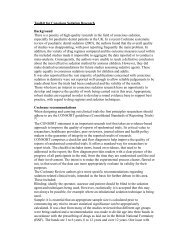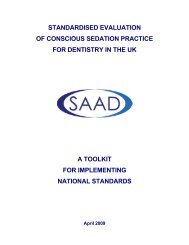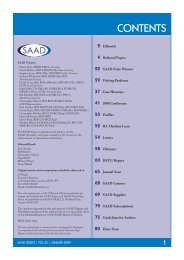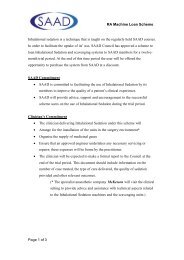Volume 24 - The Society for the Advancement of Anaesthesia in ...
Volume 24 - The Society for the Advancement of Anaesthesia in ...
Volume 24 - The Society for the Advancement of Anaesthesia in ...
You also want an ePaper? Increase the reach of your titles
YUMPU automatically turns print PDFs into web optimized ePapers that Google loves.
REFEREED PAPER<br />
described some feel<strong>in</strong>gs <strong>of</strong> dental anxiety, which could<br />
usually be attributed to a traumatic dental experience <strong>in</strong><br />
<strong>the</strong> past.<br />
‘I had an abscess, and he gave me <strong>in</strong>jections and pulled<br />
it, it was absolutely agony. I won’t go… if someth<strong>in</strong>g bad<br />
needs do<strong>in</strong>g, I’ll get it done but I won’t go back aga<strong>in</strong>.<br />
Like me, he’s not happy go<strong>in</strong>g to <strong>the</strong> dentist. My teeth are<br />
rotten, but I won’t go to <strong>the</strong> dentist.’<br />
A number <strong>of</strong> parents specifically mentioned that receiv<strong>in</strong>g<br />
dental treatment under DGA as a child had been a key<br />
causative factor <strong>in</strong> <strong>the</strong>ir own anxiety.<br />
‘I remember be<strong>in</strong>g three or four hav<strong>in</strong>g to be sat on me<br />
mo<strong>the</strong>r’s knee and <strong>the</strong>re’d be a mask com<strong>in</strong>g towards you, and<br />
emm, I particularly don’t like go<strong>in</strong>g to <strong>the</strong> dentist now myself.’<br />
Several parents were aware that <strong>the</strong>ir own anxiety had<br />
<strong>in</strong>fluenced <strong>the</strong>ir children.<br />
‘I th<strong>in</strong>k a lot <strong>of</strong> <strong>the</strong> problem with children go<strong>in</strong>g to <strong>the</strong> dentist<br />
is that <strong>the</strong>y hear so many people, adults and kids, say<strong>in</strong>g “I<br />
hate <strong>the</strong> dentist” and <strong>the</strong>y don’t know why, but <strong>the</strong>y just know<br />
it’s someth<strong>in</strong>g to be disliked.’<br />
A proportion <strong>of</strong> parents mentioned that <strong>the</strong>y undergo<br />
rout<strong>in</strong>e dental treatment under CS <strong>the</strong>mselves. One<br />
parent said that she was so anxious that she could only<br />
receive dental treatment under DGA.<br />
Patient/parental perceptions <strong>of</strong> CS<br />
As mentioned earlier, <strong>the</strong>re was some confusion as to<br />
exactly how anxiety would be controlled, <strong>in</strong> terms <strong>of</strong> <strong>the</strong><br />
use <strong>of</strong> CS and DGA. Only four parents specifically stated<br />
that CS would be used. Some children struggled with <strong>the</strong><br />
concept <strong>of</strong> CS.<br />
‘Is sedation when you get put to sleep?’<br />
However, o<strong>the</strong>rs had a good understand<strong>in</strong>g <strong>of</strong> CS.<br />
‘Sedation is just where it relaxes you and you go to sleep if you<br />
want to go to sleep.’<br />
Several parents were under <strong>the</strong> impression that <strong>the</strong>ir child<br />
had been referred <strong>for</strong> treatment under DGA. Perceptions<br />
<strong>of</strong> <strong>the</strong> service were generally based on <strong>in</strong><strong>for</strong>mation from<br />
<strong>the</strong> referr<strong>in</strong>g dentist, but also word <strong>of</strong> mouth, particularly<br />
<strong>in</strong> children.<br />
‘When he talked to his friends at school, a lot <strong>of</strong> <strong>the</strong>m have<br />
said “I’ve been <strong>the</strong>re, I’ve been <strong>the</strong>re”. And everybody was<br />
say<strong>in</strong>g good th<strong>in</strong>gs, so he felt it can’t be that bad if <strong>the</strong>y’ve been<br />
<strong>the</strong>re.’<br />
<strong>The</strong>re was a general feel<strong>in</strong>g that it was not ideal <strong>for</strong><br />
children to receive dental treatment under DGA. Two<br />
parents made <strong>the</strong> po<strong>in</strong>t that DGA is a means to an end<br />
(achievement <strong>of</strong> oral health).<br />
‘I don’t th<strong>in</strong>k it solves <strong>the</strong> problem, with my first daughter it<br />
didn’t solve <strong>the</strong> problem with her fear <strong>of</strong> <strong>the</strong> dentist. She had<br />
<strong>the</strong> treatment done, but she has still has that fear.’<br />
‘<strong>The</strong> answer isn’t to go to <strong>the</strong> hospital and get your teeth pulled<br />
out. That isn’t <strong>the</strong> answer at all. It doesn’t get rid <strong>of</strong> his fear. It<br />
gets rid <strong>of</strong> <strong>the</strong> teeth that needed remov<strong>in</strong>g, he’s not awake and<br />
he’s not aware <strong>of</strong> what’s happen<strong>in</strong>g, but it doesn’t solve <strong>the</strong><br />
problem.’<br />
However, it was accepted that DGA could be used as a<br />
last resort, if all o<strong>the</strong>r attempts at treatment had failed.<br />
‘You don’t obviously want to be knock<strong>in</strong>g every kid out with<br />
general anaes<strong>the</strong>tic, it’s not ideal by any means. Well if you’ve<br />
tried everyth<strong>in</strong>g you’ve got <strong>in</strong> your armoury and it still hasn’t<br />
worked <strong>for</strong> one reason or ano<strong>the</strong>r, you don’t really have any<br />
choice do you.’<br />
DGA was perceived to be less safe than CS.<br />
‘<strong>The</strong>re’s always a risk with a general anaes<strong>the</strong>tic. I don’t<br />
th<strong>in</strong>k <strong>the</strong>re’s always such a risk with sedation. When<br />
somebody is sedated <strong>the</strong> sedation will work <strong>of</strong>f. When you’re<br />
us<strong>in</strong>g anaes<strong>the</strong>tic, <strong>the</strong>re’s <strong>in</strong>duction agents, and sometimes,<br />
well I’d th<strong>in</strong>k more <strong>of</strong>ten than not, when <strong>the</strong>y are under<br />
general anaes<strong>the</strong>tic, somebody else is do<strong>in</strong>g <strong>the</strong> breath<strong>in</strong>g and<br />
everyth<strong>in</strong>g <strong>for</strong> <strong>the</strong>m. I th<strong>in</strong>k that’s a risk.’<br />
Treatment<br />
Was a separate assessment visit useful?<br />
This question created a def<strong>in</strong>ite difference <strong>of</strong> op<strong>in</strong>ion<br />
between subjects. A slim majority were <strong>in</strong> favour <strong>of</strong> a<br />
separate assessment visit. Those who were <strong>in</strong> favour<br />
liked <strong>the</strong> opportunity <strong>for</strong> explanation <strong>of</strong> procedures<br />
and discussion <strong>of</strong> anxiety management options. It also<br />
provided <strong>the</strong> chance <strong>for</strong> children to familiarise <strong>the</strong>mselves<br />
with <strong>the</strong> practice and staff.<br />
‘**** wouldn’t have gone if she thought it was all go<strong>in</strong>g to be<br />
done <strong>the</strong>re and <strong>the</strong>n. She wanted to go and have a look and see<br />
what was go<strong>in</strong>g to happen.’<br />
Those who were aga<strong>in</strong>st <strong>the</strong> concept <strong>of</strong> a separate<br />
assessment visit found it <strong>in</strong>convenient <strong>in</strong> terms <strong>of</strong> time<br />
taken <strong>of</strong>f work (parents), or school (children) or would<br />
just have preferred to have got <strong>the</strong> treatment over and<br />
done with. Where <strong>in</strong>correct <strong>in</strong><strong>for</strong>mation was given<br />
regard<strong>in</strong>g separate assessment and treatment visits,<br />
unnecessary anxiety was caused to <strong>the</strong> child <strong>in</strong>volved.<br />
‘We went to <strong>the</strong> first appo<strong>in</strong>tment th<strong>in</strong>k<strong>in</strong>g she was gett<strong>in</strong>g it<br />
out <strong>the</strong>re and <strong>the</strong>n and she was petrified.’<br />
Explanation and <strong>in</strong>volvement<br />
<strong>The</strong> <strong>in</strong>volvement <strong>of</strong> parents, but particularly children,<br />
<strong>in</strong> discussion <strong>of</strong> treatment and anxiety management<br />
options was strongly felt to be a positive feature. Children<br />
generally liked to be treated as <strong>in</strong>dividuals and to be<br />
actively <strong>in</strong>volved <strong>in</strong> <strong>the</strong> decision-mak<strong>in</strong>g process.<br />
‘<strong>The</strong>y tell you what’s go<strong>in</strong>g to happen and <strong>the</strong>y say if you don’t<br />
feel com<strong>for</strong>table with that happen<strong>in</strong>g you have o<strong>the</strong>r options.’<br />
‘I th<strong>in</strong>k <strong>in</strong>volve him <strong>in</strong> <strong>the</strong> process, and give him <strong>the</strong><br />
<strong>in</strong><strong>for</strong>mation he needs and let him decide if he wants it or<br />
SAAD DIGEST | VOL.<strong>24</strong> | JANUARY 2008 7




